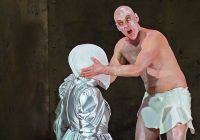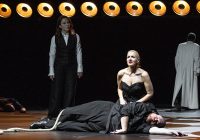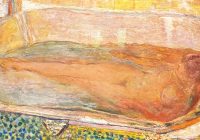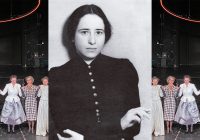Giacometti im Guggenheim Museum New York
Von Kory Apton
12.07.2018
english text below
Wertung: 🙂 🙂 🙂 🙂 🙂 (fünf von fünf)
Die vielen Ebenen von Giacomettis Kunst.
Liebe Leser, wenn Ihr große Retrospektiven berühmter Künstler mögt, die in den letzten 100 Jahren relevant waren, ist diese Show genau das Richtige für Euch. Die Ausstellung „Giacometti“ fasziniert auf vielen Ebenen. Der Besucher kann seine gesamte künstlerische Laufbahn und sein Leben chronologisch auf einer gewundenen, spiralförmigen Rampe sehen, im einzigartigen Guggenheim-Museum in New York.
Giacomettis Skizzen, Gemälde, Skulpturen und persönliche Erzählungen entwickeln sich, wenn Sie die Rotunda hinaufsteigen. Er war von Menschen besessen und verbrachte ein Leben damit, sie zu beobachten und zu studieren.
„Auf der Straße verblüffen und interessieren mich die Menschen mehr als jede Skulptur oder Malerei“, sagte Giacometti. „Sie bilden unaufhörlich lebendige Kompositionen in unglaublicher Komplexität.“
Hier in dieser Ausstellung „Giacometti“ im Guggenheim Museum New York imitiert die Kunst das Leben.
Erotik, Leiden und Ambivalenz sind die wesentlichen Merkmale. Giacomettis Skizzen sind meisterhafte Zeichnungen, die Gemälde unheimlich bezaubernd und die Skulpturen tiefgründig. Die Giacometti-Figuren scheinen sich mit eigenem Willen und Energie zu bewegen. Sie können beängstigend sein, ohne Muskeln und Sehnen, abgemagert und wild.
Es scheint, so mehr Giacometti ich sehe, umso mehr verstehe ich den Menschen.
Alberto Giacometti wurde 1901 in eine Schweizer Künstlerfamilie hineingeboren. Als junger Mann zog er in den 1920er Jahren nach Paris, dem damaligen Schmelztiegel von Kunst und Kultur in Europa. Giacometti wurde am Anfang seiner Karriere nicht immer bewundert, doch er war einzigartig.
„Je mehr Du scheiterst, desto mehr gelingt Dir“, war sein Mantra.Giacomettis Kunst spiegelt die Folter, Schmerz und Angst wider, mit der er in seinem Leben konfrontiert wurde. An einer Stelle der Ausstellung sehen wir „Disagreable Object“, eine Skulptur, die brutal phallisch wirkt. Dann „Women with the Throat Cut“ ist gruselig und verwirrend, denn es sieht aus wie ein Insekt aus einem Horrorfilm. War es der Einfluss des Surrealismus, vermischt mit Fantasie und Tod oder die Hässlichkeit des Zweiten Weltkriegs, die Giacomettis Gefühl von Furcht und Schmerz so anwachsen ließ?
Vom 10. Mai 1940 bis zum 25. August 1944 war Paris von den Nazis besetzt. In dieser Zeit besuchte er einmal seine Mutter in Genf. Als er wieder zurück wollte wurde er an der Grenze aufgehalten und ihm der Wiedereintritt nach Frankreich verweigert. Dabei wurde er Zeuge, wie einem Mitreisendem neben ihm ins Gesicht geschossen wurde. Das Gesicht des Mannes spritzte überall auf den Künstler. Das Erlebnis verarbeitete er in seiner Skulptur „The Nose“. Giacometti sah die Nase in dem entstellten Gesicht des Mannes wachsen. Bei meinem Besuch der Ausstellung posierte ein kleines Kind neben der Skulptur „The Nose“ und war sichtlich fasziniert. Die Mutter machte ein Foto, während Das Kind das Wachstum seiner eigenen Nase mit seinen Händen imitierte, um sein junges Gesicht zu verlängern. Die Skulpturen lassen den Besucher etwas fühlen, auch wenn Sie die Ängste des Künstlers nicht kennen.
Während ich in der Rotunde höher steige meine ich den Schmerz des Künstlers zu spüren. Die in Bronze, Eisen und Metall gegossenen Figuren ähneln Holocaustopfern und Hungersnöten. Doch in jeder Skulptur liegt Würde und Schönheit.
Die kleinste Skulptur der Ausstellung ist nur 2,75 Zentimeter hoch und eine der faszinierendsten, weil sie so kraftvoll ist wie die großen Stücke, die Giacometti während seiner gesamten Karriere geschaffen hat. Er verbrachte ein Leben damit, Menschen zu beobachten und reduzierte seine Meisterwerke auf ihre Essenz.

4 Photos: Ausstellung „Giacometti“ im Guggenheim Museum in New York, Foto: David Heald © Solomon Guggenheim Foundation
Das Guggenheim gibt Giacomettis Kunst innerhalb des spiralförmigen Gebäudes noch einmal eine große Energie. Es scheint, dass der Künstler ganz nahe bei uns ist und uns beobachtet.
„Ich habe das Gefühl oder die Hoffnung, dass ich jeden Tag Fortschritte mache“, sagte Giacometti einmal. „Das ist es, was mich dazu bringt, zu arbeiten und den Kern des Lebens zu verstehen.“
New York City ist dieser Kern des Lebens, ein Schmelztiegel der Menschheit und ein wunderbarer Ort, um Menschen zu beobachten, so wie es Giacometti getan hat. Wir bewegen uns hier nebeneinander, im Museum und auf den Straßen, zusammen und getrennt. Wir mögen anders aussehen, aber wir sind alle Kompositionen aus demselben Material. Zumindest hatte Giacometti das herausgefunden.
„Giacometti“
5. Juni – 12. September 2018
Solomon R. Guggenheim Museum und Stiftung
One Liberty Plaza New York,
NY 10006
USA
FR – Mi 10.00 – 17.45 Uhr, Di im Sommer (bis 11. September) bis 21.00 Uhr, Do geschlossen
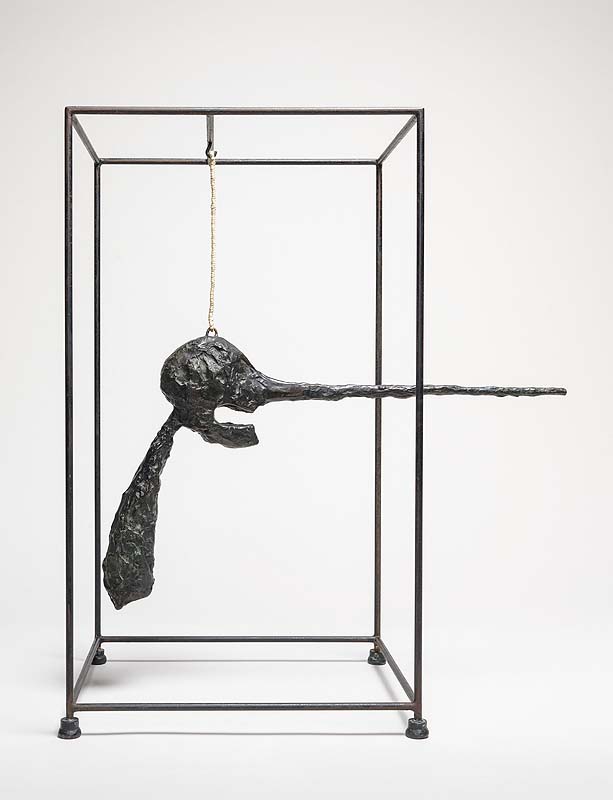
6 Photos: „The Nose“, 1949, Ausstellung „Giacometti“ im Guggenheim Museum New York © Alberto Giacometti Estate
english text
Giacometti at Guggenheim Museum New York
The many levels of an artist
By Kory Kim Apton
Dear reader, If you like big retrospectives of famous artists who were relevant in the last 100 years, this show is for you. Giacometti is intriguing on many levels, primarily because you get to see his entire artistic career and life unfold chronologically on a winding, spiral ramp which leads to heavenly domed skylight at the unique Guggenheim Museum in New York.
Giacometti’s sketches, paintings, sculptures and personal narrative evolve as you ascend the show. He was obsessed with people and spent a lifetime observing them. „In the street people astound and interest me more than any sculpture or painting,“ Giacometti said. „Every second the people stream together and go apart, then they approach each other to get closer to one another. They unceasingly form and re-form living compositions in unbelievable complexity.… It’s the totality of this life that I want to reproduce in everything I do.”
So here is that totality; the cross section of humanity buzzing around a hive like rotunda, admiring and contemplating art, in the greatest city in the world. Life imitates art, you get two exhibitions in one.
Eroticism, suffering and ambivalence persevere in this show. The sketches are master doodles, the paintings eerily enchanting and the sculptures profound. The Giacometti figures move with purpose and energy. They can be scary, stripped of muscle and sinew, emaciated and fierce. The more Giacometti you see the more you understand people.
The beginning of the exhibition has three magnificent sculptures; two tall, leaning, wraith like human figures, one male, one female and one highly textured face. These are classic Giacometti’s, instantly recognizable and bold. This makes you feel good, like recognizing an old acquaintance.
Keep going and you will see how he began; there are playful carvings that children could have made, mixed with some simpler smooth and pleasing forms that began to bring him attention in addition to well composed portraits.
Giacometti was born to a family of artists in Switzerland in 1901, so you could say talent was in his DNA. He then moved to Paris as a young man in the 1920’s when famous writers, painters, art critics and dealers were propelling art forward at a fast pace. Giacometti was not always admired in the beginning of his career, but he was one of a kind and dedicated to his craft. “The more you fail the more you succeed,” was his mantra. He produced a large body of work throughout his life. Giacometti may have been influenced by the styles and artists of his time, but he is unique. Isn’t that the art jack pot, to be original?
Keep ascending the spirals of the Guggenheim and the influence of cubism emerges with ‘Spoon Women’. It’s an amusing piece made from plaster, and beside it is replica in bronze. Kids will be beguiled if you ask them to tell you what they see: “A woman swallows the spoon and becomes one so that she can eat up all her experiences.”
Climb further and surrealism rears its ugly, imaginative head. The older we get and the more we know, the more we fear. Giacometti’s art begins to reflect the torture he confronts in his life. The show becomes more intense with ‘Disagreeable Object’ which is brutally phallic. ‘Women with her Throat Cut’ is creepy and confusing since it also looks like an insect from a horror film. Was it the influence of surrealism mixed with fantasy and death, or the ugliness of World War II that made Giacometti’s pain so fascinating?
The Nazis occupied Paris between May 10, 1940 and Aug. 25 1944. Giacometti left his studio to visit his mother in Geneva and was supposedly denied reentry into France. During this time hewitnessed a travelling companion shot in the face. The man’s face splattered all over the artist which in turn haunted the next series of sculptures. Clearly, mortality consumed Giacometti as he lived with the atrocities of World War II.
‘The Nose,’ is an intensely disturbing but passionate piece as result of this murder. Giacometti saw the nose growing in the man’s disfigured face. At this show an innocent American child posed next to ‘The Nose’ and was clearly intrigued by the famous sculpture displayed in its own cage. The mom took his picture as he mimicked the growth of his own nose using his hands to elongate his young face. These sculptures make you feel something even if don’t know the artist’s fears.
Climb higher up the rotunda and feel the pain and ambivalence of the artist as he ages. The figures cast in bronze, iron and metal resemble holocaust victims and starvation. Yet there is dignity and beauty in every sculpture because a spirit emerges from the fleshless figures. They move with momentum, onward and upward. They are all going places and going with a purpose. The busts on the other hand appear full, with additional flesh and then more flesh piled on composed like a drip castle. Giacometti was evidently struggling to get to the core of the people who were posing for him. Was he ever satisfied with these compositions?
The tiniest sculpture in the show is a mere 2.75 centimeters high and one of the most fascinating because it is as powerful as the large scale pieces that Giacometti created throughout his career. He spent a lifetime observing humans but he reduced these miniatures pieces to their essence; no color barriers, no borders, no religion, just soul and they are every bit as intricate and complex as the rest of the show.
The Guggenheim enhances Giacometti’s art because of the energy within the spiraling edifice. The artist is somewhere inside with us, observing us. „I have the feeling, or the hope, that I am making progress each day,“ Giacometti once said. „That is what makes me work, compelled to understand the core of life.“ New York City is that core of life, a melting pot of humanity and a wonderful place to observe people much like Giacometti did. We move side by side here, in the museum and on the streets, together and apart. We might look different, but we are all compositions of the same material. At least Giacometti had that figured out.
„Giacometti“
June 5 – September 12, 2018
Solomon R. Guggenheim Museum and Foundation
One Liberty Plaza
New York, NY 10006
USA
Fr – Wed 10 am – 5.45 pm, Tuesday Summer (until 11th of Sept) open to 9 pm, Thursday closed
Author: Kory Apton
Kory Apton is TV Producer and Storyteller at Conglomerate Media in New York and Miami








